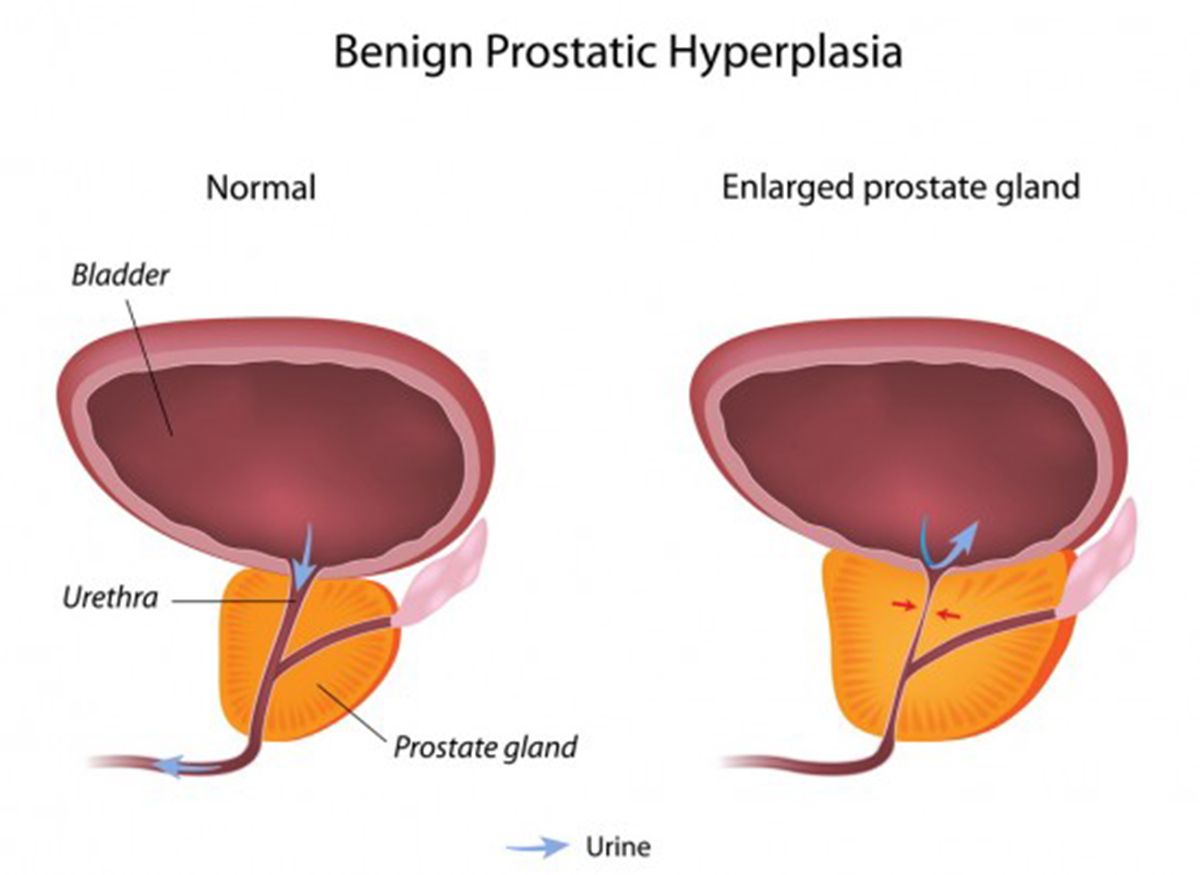Prostate cancer may be getting all of the press right now — not to mention a lot of mustaches, thanks to No-Shave November! — but men are, in fact, much more likely to develop benign prostatic hyperplasia (BPH) at some point in their lives. It's the most common benign tumor growth in aging men, with about 70 percent of men diagnosed by the time they are 60 years old and a whopping 90 percent diagnosed by the age of 70. Crazy, right? Almost half a million men undergo surgery to correct BPH each year. So, what is it?
Keep reading to find out more about benign prostatic hyperplasia and how you can manage and treat it. Let's take a look.

It's Benign
The best part of BPH is that the 'B' stands for benign.
What's happening is that the stromal and epithelial cells of the prostate are stimulated by a derivative of the male sex hormone testosterone which is called dihydrotestosterone. (The stroma is the foundational skin layer of an organ and the epithelium is the surface layer.) At the same time, aging men have an increased concentration of estrogen in their systems. The estrogen actually increases the amount of hormone receptors in the prostate. More hormone receptors combined with more hormones means that the prostate nodules start to enlarge and quickly.
Okay, so it's not cancerous, but how can it affect your health?
Why is that Bad?
Even though it's jst benign, and isn't cancerous, BPH has a negative effect on a man's overall well-being. The prostate is normally a small gland that is practically wrapped around the the neck of the bladder and the urethra in men. Think of it as your fingers around the neck of a balloon. When you hold it loosely, air can escape the balloon easily. Held tightly, however, the air stays put or comes out slowly and in fits and starts. Now imagine that full balloon is your bladder and hold on tight to the neck. As you can begin to picture in your mind, an enlarged prostate is an uncomfortable situation.
If BPH is such a common occurance, how can I tell that I have it? We'll be looking at that next.
How Do I Know if I Have BPH?
The most noticeable sign is that you have trouble urinating. It could be problems starting up or stopping or it could be constantly feeling as if you need to urinate. Waking up multiple times in the night to use the bathroom is another common indicator that you might have BPH. Since it's so difficult to empty the bladder, urinary tract infections can develop. Sometimes, men will suffer from acute urinary retention. This is when they're unable to urinate at all, not a good thing in the least. That can lead to kidney damage, bladder hypertrophy (increase in size), hydronephrosis (stretching of the kidney tissues), and even sepsis.
These tests will include a urinalysis and a digital rectal exam. The urinalysis checks for a variety of issues, while the exam allows the doctor to confirm that the prostate is enlarged.
Read More: Prostate Enlargement: Benign Prostatic Hyperplasia (BPH) Symptoms and Treatment
Can I Just Take a Pill?
It depends on how bad the symptoms are. For men with mild or moderate symptoms, some prescription medications like alpha blockers and 5-alpha-reductase inhibitors are used to reduce or even eliminate the problems. Alpha blockers relax the muscles of the prostate and the urethra to allow urine to flow more easily, while 5-alpha-reductase inhibitors can actually shrink the prostate when taken consistently over the course of a year. Both classes of drugs come with side effects, though. These range from headaches and dizziness to impotence and ejaculatory dysfunction.
What Are My Other Options?
With so many men diagnosed each year, there are quite a few. They range from minimally invasive procedures to moderately complex surgeries and each come with their own risks.

Get it Out
A small, spring-like device is inserted into the portion of the urethra that is surrounded by the swollen prostate in order to keep it open. It's generally only used for people who cannot have surgery because it can cause serious complications like incontinence or stone formation on the stent. Another option is catheterization.
The patient inserts a flexible tube into the urethra, maneuvering it past the constricted area and up to the bladder to allow urine to drain. Catheterization can be intermittent (done around the clock), short-term (a special catheter that can be left in place for up to three months), or long-term (a catheter is actually inserted through a puncture made up above the pubic bone).
Shrink it Down
There is a wide variety of options in this category. The most complicated is a transurethral resection of the prostate (TURP), which is performed under anesthesia.
The pieces that are cut away are flushed into the bladder, then out the urethra. Afterwards, a catheter is left in place and the bladder is continually flushed with fluid for the duration of a one to two day hospital stay.
Newer treatments use lasers, microwave thermatherapy, or high-frequency radio waves to apply focused heat to areas of the prostate, effectively burning the tissue away. These procedures can be performed as outpatient surgeries or even within a doctor's office. Photoselective vaporization of the prostate (PVP) is quickly becoming the best option for BHP. A high-powered laser vaporizes prostate tissue with minimal bleeding and side effects and works just as well as traditional surgical procedures.
What Else Can I Do?
If you're a man, you will probably end up with a BPH diagnosis at some point in your life. There are some things you can do to help stave off the inevitable, though.
Read More: Enlarged prostate: Prostate Laser Surgery
Alcohol consumption should be minimized. It all sounds very disheartening, but be aware that there is one rather enjoyable thing you can do to minimize BPH: regular sexual intercourse actually helps relieve congestion in the prostate.
Of course, your doctor can't write a prescription for that.
- Hyperplasia. (2001). In Taber's Cyclopedic Medical Dictionary (p.988, Edition 19). Philadelphia, PA: F. A. Davis Company.
- Hydronephrosis. (2001). In Taber's Cyclopedic Medical Dictionary (p.973, Edition 19). Philadelphia, PA: F. A. Davis Company.
- Prostate. (2001). In Taber's Cyclopedic Medical Dictionary (pp.1691-1692, Edition 19). Philadelphia, PA: F. A. Davis Company.
- Photo by shutterstock.com
- Photo courtesy of faungg's photo by Flickr : www.flickr.com/photos/44534236@N00/3840983806/


Your thoughts on this